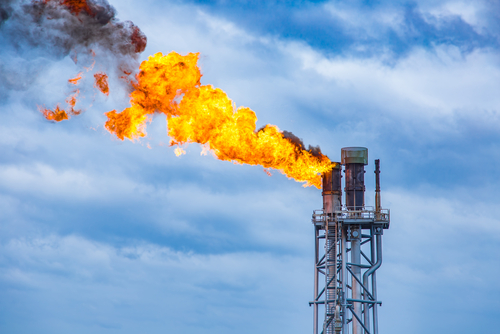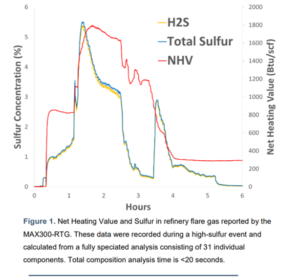Flare Compliance at Oil Refineries

Flare Compliance at Oil Refineries
EPA Refinery Sector Rule (RSR) 40 CFR 63 Flare Gas Compliance with Total Composition Monitoring
January 30, 2019 is the compliance deadline for the latest update to the US EPA Refinery Sector Rule (RSR). This will require additional monitoring and gas analysis when regulated material is sent to the flare. The MAX300-AIR, environmental gas analyzer, provides a rapid, speciated analysis of vent gas composition that many refineries are currently using for EPA compliance. According to new requirements in the General Provisions, flares used as Air Pollution Control Devices (APCD) are expected to achieve 98% Hazardous Air Pollutant (HAP) destruction efficiencies. These updated requirements include monitoring of the pilot flame, visible emissions, flare tip velocity, net heating values, and dilution parameters, as well as maintaining a Flare Management Plan and a Continuous Parameter Monitoring System Plan.
The Net Heating Value of the gas in the Combustion Zone (NHVCZ) is of particular importance as it has a direct impact on combustion efficiency. As a result, the RSR update mandates a NHVCZ ≥ 270 Btu/scf, based on a 15-minute block average, when regulated material is sent to the flare for at least 15 minutes. For flares actively receiving perimeter assist air, NHVdil must be greater than or equal to 22 Btu/ft2, when regulated material is sent to the flare. To meet this requirement, continuous direct measurements of refinery vent gas must be made. High variability, sulfur content, and corrosivity can make these samples difficult for many analytical techniques.
The MAX300-RTG 2.0 real-time gas analyzer is currently used at many US refineries for NSPS Subpart Ja sulfur monitoring. The analyzer measures the full, speciated composition of the flare gas and delivers continuous updates of NHV, H2S, and Total Sulfur several times per minute (Fig. 1). Rapid updates of NHV are critical for compliance because the refinery must be able to both monitor and control the gases at the flare tip within the regulated 15-minute block. The additional information provided by full speciation can be used at RSR sites for Ja sulfur compliance, validating or replacing existing sulfur analyzers, as well as for operational control and accurate root cause analysis.

The regulation provides multiple ways to calculate the Net Heating Value of the gas in the Combustions Zone (NHVCZ) for RSR reporting, but all methods use the Net Heating Value of the Vent Gas (NHVVG) as an input. In fact, several parameters, including NHVCZ, NHVdil, and each flare’s specific maximum tip velocity (Vmax), are determined based on NHVVG, making this value one of the key components of reporting compliance and effective flare control. Direct measurements of vent gas composition can be used to calculate NHVVG and high precision gas analysis ensures accurate, actionable NHVVG data (Table 1). When regulated material is sent to the flare, NHVVG changes dramatically as hydrogen and hydrocarbon concentrations in the stream spike and recede. Regardless of the BTU content of the sample, the MAX300-RTG maintains constant, high precision on the NHV parameter due to the inherent repeatability of the gas analysis.